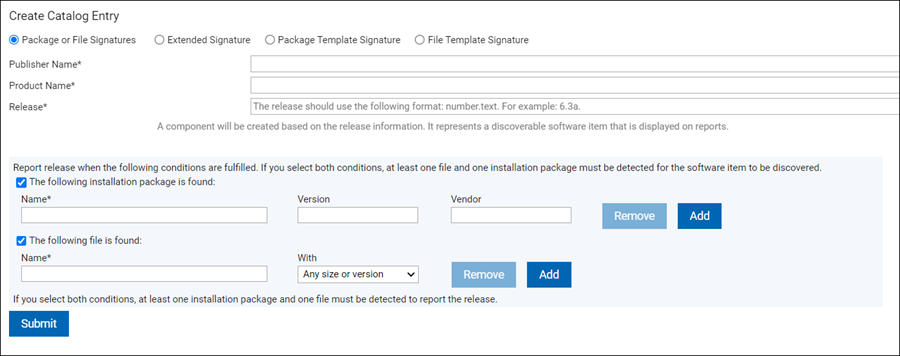You can use package data to expand your custom catalog. You can add signatures for
software products that are installed in your infrastructure but are not present in the HCL® catalog.
Before you begin
 You must have the View Raw Data, View Endpoints and Manage Catalogs permissions to perform
this task.
You must have the View Raw Data, View Endpoints and Manage Catalogs permissions to perform
this task.
Procedure
-
 For versions 9.2.11 and higher
For versions 9.2.11 and higher
-
Log in to BigFix Inventory, and go to .
-
Set up the relevant filters, and identify the packages that you want to create signatures
for.
-
Check one or more packages. You can select up to twenty packages at a time.
-
Hover over the Signature icon
 and click Add Signature.
and click Add Signature.
Note: You cannot create a signature on a Package Data report, if you already added either a file or
an extended signature for the component with the same details. If you create a package signature for
a component that is a part of a basic catalog, the component and the detection will be duplicated.
-
For versions before 9.2.11
-
Log in to BigFix Inventory, and go to .
-
To filter the report data, hover over the Manage Report View icon
 , and click Configure View. Then, specify the appropriate filtering
options.
, and click Configure View. Then, specify the appropriate filtering
options.
Note: To find a file or a package that can be used as a
signature, filter the report to the data from the computer on which the particular
software product is installed. To further narrow down the results, specify the whole or
part of the path to the directory where the software is installed. Then, look at the
following columns.
- Recognized - the column shows whether the package data and/or
file was recognized as part of an existing signature.
- Removed since
 : Caused Detection - the column shows whether the file
contained enough information to cause detection of the related software. The Caused
Detection column is removed since BigFix Inventory version 10.0.4. You
must re-create your saved reports in case you had used the Caused Detection
column.
: Caused Detection - the column shows whether the file
contained enough information to cause detection of the related software. The Caused
Detection column is removed since BigFix Inventory version 10.0.4. You
must re-create your saved reports in case you had used the Caused Detection
column.
If the value in both columns is
No, the file is not used for
software detection and you can use it to create a new software signature.
-
In the Name column, look for the location where the missing software
title is installed. Click the arrow on the right from the Name of the file
that you want to use as a signature, and click Create Signature.
-
In the Create Catalog Entry window, provide the publisher name, product
name, and release number.

 To create a template signature with auto-detectable version of the package,
you may choose the Package Template signature type and copy data from the Package or
File Signatures tab to the template type. For more details, see Creating signatures.
To create a template signature with auto-detectable version of the package,
you may choose the Package Template signature type and copy data from the Package or
File Signatures tab to the template type. For more details, see Creating signatures.
Tip: The most efficient signatures are file-based signatures with a constant size that
is different for each release, or signatures that are based on registry entries
where a wildcard (*) can be used. You can use a wildcard in the
Name and
Version fields for a package. A wildcard represents any string and can be
combined with other characters. You can use an asterisk '*' character not combined
with other characters in the
Vendor field for a package (meaning any vendor).
For example, you can use IBM * SDK for Java™, 5.*, * for the name, version, and
vendor fields.
Note: 
A detailed package
version that is discovered is shown in the 'Component Detailed Version' column
in the Software Classification report and 'component_detailed_version' column in
REST API.
-
To save the catalog entry, click Submit.
Important: If you create an entry that exists in the software catalog an
informational message is displayed, and both signatures are saved in the
catalog.
Results
You added a software signature to your custom catalog, and it can now be used to detect
software. When you create signatures from package data, the custom content version of the software
catalog remains the same, because the signatures are matched on the server side, and no new catalog
needs to be created.You can view the audit trail of the changes on the Catalog
Audit report.
What to do next
You can edit the details of the signature and delete a custom catalog entry on the
Catalog Customization panel.
 You must have the View Raw Data, View Endpoints and Manage Catalogs permissions to perform
this task.
You must have the View Raw Data, View Endpoints and Manage Catalogs permissions to perform
this task. For versions 9.2.11 and higher
For versions 9.2.11 and higher

